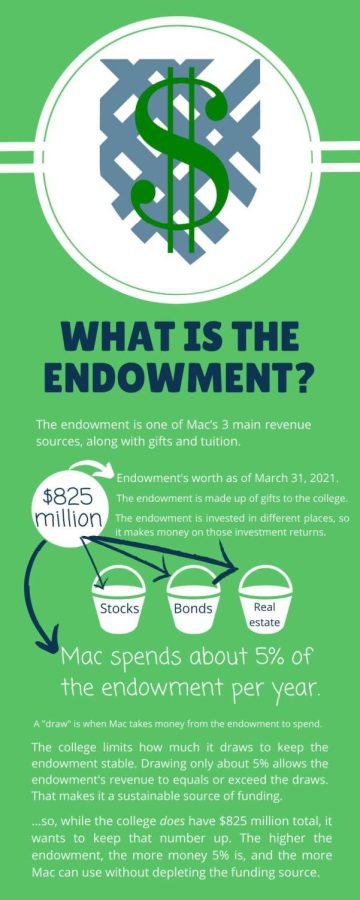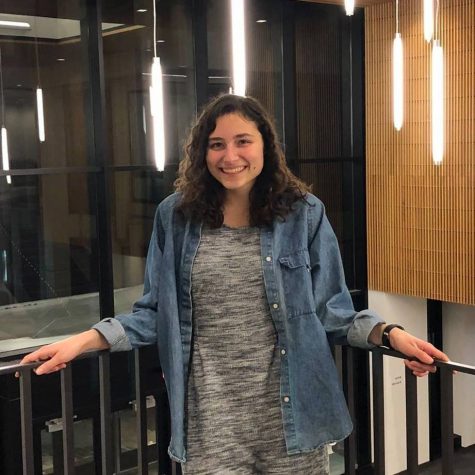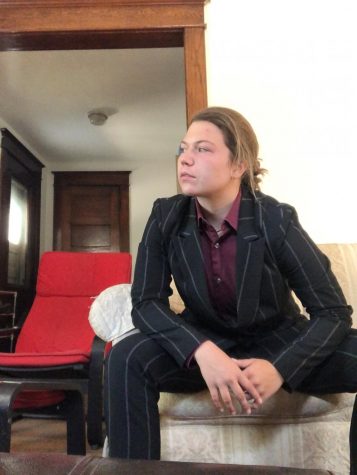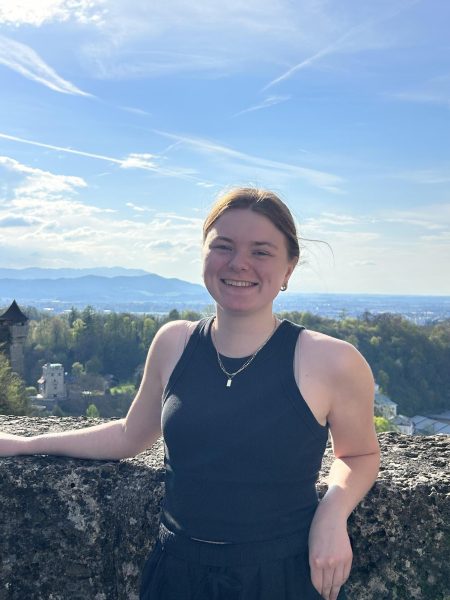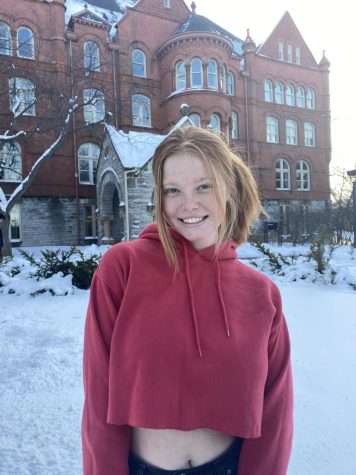In search of financial transparency: Fundraising and communication amid administrative change
April 14, 2022
For years, students have asked for greater transparency around Macalester’s finances and spending. Until the end of its work last fall, the student organization Fossil Free Mac made transparency a top demand in its campaign for divestment from fossil fuels. In August 2021, when the board of trustees decided to divest, they also tasked its Governance Committee to identify ways in which the board can increase transparency with the campus community. At November’s student sit-in, students once again raised questions about Macalester’s financial affairs.
Students and community members often struggle to find this information; even when they find it, it’s often difficult to understand the technical or economic language. This academic year, marked by student demands, a new administration and a new strategic planning process, students and staff are asking what transparency means and examining the information coming out of these efforts.
Where Mac’s finances stand
Last fall, Macalester embarked on a new strategic planning process, which the college will use to shape its direction and spending over the next several years. When the process began, the school decided it needed to provide background to help people understand where its finances stand.
The Strategic Planning and Analysis committee compiled a document outlining Macalester’s financial model at the beginning of this school year. With 11 pages of graphs, statistics and analysis, the packet sought to put lots of hard-to-find information in one place that students, faculty and staff could access.
Plenty of community members did read the document — and it sparked a number of questions. Beth Severy-Hoven, the chair of the Faculty Advisory Committee and professor in the department of classical Mediterranean and Middle East, said that she and other faculty have discussed the information.
“We spent a lot of time talking about — in a way educating ourselves — on the basics of the college’s finances, and making it clear that clearly there are some problems that need addressing,” Severy-Hoven said.
One thing that caught various professors’ attention were the graphs comparing Macalester’s finances to its “peer 40” schools — a group of private liberal arts colleges similar to Macalester in size. From 2004 to 2014, Macalester’s endowment grew an average of 5.1% per year, which was close to the median of the peer 40 schools, coming in at 5.5%.
From 2014 to 2020, though, Macalester’s endowment shrank by 1.2% per year, compared to a peer 40 median increase of 2% per year.
Macalester also lags behind those peer 40 in other revenue areas; it ranks 37th out of 41 in the amount of revenue from private gifts.
The lag is not necessarily a cause for alarm, according to David Schuman, associate professor of mathematics, statistics and computer science as well as one of the authors of the financial model packet. He spoke to The Mac Weekly about the main takeaways of the document shortly after its publication in October.
In a few different places, Macalester lags behind the peer 40. One of those categories is in gifts to the college.
“We have trouble fundraising compared to our peers,” Schuman said. “And I don’t think it’s a red flag. It’s something everybody on campus knows.”
Internally, Macalester’s alumni giving has fallen by 14 percentage points in the last eight school years–– from 36% in 2014 to 22% in 2021. Ten of those percentage points fell off in the last two school years. This follows the national drop in alumni participation, according to Vice President for Advancement Andrew Brown, who explained how Macalester is looking at alumni participation.
“Alumni participation percentage is a metric that gets a lot of attention, but it actually isn’t very useful in measuring the strength of an annual giving program,” Brown wrote in an email to The Mac Weekly.
Brown said that this is because the pool of graduated students grows faster than it loses alumni. It’s not that alumni who previously donated are stopping their donations; as students graduate, the alumni pool gets bigger, and there are less new donors.
But it’s more than a question of numbers: Macalester alumni choose to donate to the college at lower rates than alumni of the school’s peer institutions.
“Your average Macalester person doesn’t want to go into a big corporate job,” Rebecca Gentry ‘23, chair of the Macalester Student Government’s (MCSG) Financial Affairs Committee (FAC), said. “Our alumni typically don’t earn as much as other alumni.”
“Frankly, we just have less wealth in our student body and less wealth in our alumni bodies,” Brown said.
According to Brown, the two indicators of how much alumni will give are capacity and inclination. Capacity, how much an alumnus is able to give, is less improvable than inclination, the alumnus’ willingness to give.
“With less capacity, we have to be more creative about giving [alumni] pathways to give to the best of their ability,” Brown said.
If Macalester’s fundraising capacity is low and its endowment not performing as well as its peers’, one of its options is to lean more heavily on its last source of revenue: tuition. Compared to its peer 40 schools, Macalester ranks 35 out of 41 in the amount of revenue it gets from tuition and fees per student.
The plus side of Macalester’s lower tuition revenue — for students and their families, at least — is that Macalester can be more affordable than its peers. The school is hesitant to change that reputation by hiking up prices or lowering discount rates. That could quickly lead to a less economically diverse student body.
“We rely on an endowment to give scholarships and to make college affordable for students from all backgrounds,” Schuman said in October. “Without that endowment, without keeping growing it and getting gifts, we can’t do that, and it’s gonna become affordable, and then we’re faced with the tough decisions of, ‘do we stop admitting people from families with needs?’ Nobody wants to do that.”
The financial model document also notes that colleges relying on tuition revenue could face a bigger challenge as the “demographic cliff” approaches — the generation born around the 2008 financial crisis is smaller, which could mean less students will be applying to colleges as that age group hits 18 in a few years. Relying less on tuition revenue could be helpful for Macalester in that situation, too.
The desire to keep Macalester relatively affordable, coupled with low fundraising, leaves the school with a couple of options for increasing revenue. First, the document mentions the possibility of increasing class sizes. More students means more tuition revenue, and the financial model document notes that, since most of the college’s spending on students is fixed, expanding the student body adds more revenue than cost. But there’s a limit to how much the college can expand the student body without expanding the capacity of the dorms, on-campus dining and class sizes.
Already, the student body has grown 10% in the last ten years, according to the 2021 Macalester Fact Book. This year’s first year class has seen students crammed in lounges and waiting in long Cafe Mac lines.
“Now, we’re busting at the seams,” Severy-Hoven said. “You can feel it in the dining hall, I think you can feel it in trying to get certain classes, when there’s an emergency somewhere. And there’s only so long you can compensate for the other two by adding more bodies. We have now maxed out that route, so what do we do?”
Calls for transparency
Students and staff are still calling for more transparency and easier access to information, but several faculty members noted that transparency has increased since President Suzanne Rivera’s arrival at the college in June 2020.
Chair of the history department Walter Greason, who joined Macalester’s faculty last fall, said he has appreciated the efforts for transparency he’s seen.
“I’m never going to say any administration doesn’t have a stone wall somewhere, but I do think President Rivera and her team as they’re coming together right now want to be more transparent, and they’ve said that to me directly,” Greason said.
Students demanded increased financial transparency during events like the campaign to divest from Enbridge and the November sit-in. Gentry said she’s participated in conversations with administrators who were unsure of how to handle this call for transparency. She recalls being asked if any students would show up to learn about the school’s finances.
“Yes, of course students would show up,” Gentry said. “Students need to know.”
In response to Gentry and other student requests, info sessions were held in the fall of 2021 entitled “Let’s Talk Money: Unpacking the Endowment with Chief Investments Officer Gary Martin.” At these talks, Martin gave an overview of how the endowment works and took questions from students.
Macalester has also produced tools such as the financial model that is available to the public. It also has Macalester’s asset allocation up on its investment office website, which shows the breakdown of where the college’s endowment is invested. The Fact Book is also available with a Macalester log in.
But the fact that these exist doesn’t mean students are reading and understanding them. Gentry pointed out that she has heard no students outside of FAC or MSCG talk about the financial model despite its utility. Although these resources provide some data, Gentry says that the figures are still difficult to interpret. Students often aren’t familiar with the economic terms and details that go into these resources.
“People don’t know the language,” Greason said. “They don’t know the definitions, they don’t know how to look at the way things are categorized, it makes it very hard to look at even statements when people are being transparent to really understand what you want to know.”
Greason advocates for increased education on these topics so students and faculty can understand the college’s finances.
Although Severy-Hoven has concerns about the information that came to light with the release of the financial model document, she appreciates the fact that it came to light at all.
“I do really credit [Rivera] with a level of transparency that we have not seen before,” Severy-Hoven said. “It’s hard to hear … like, we have some problems. Now we’ll see if people will tackle them.”
Fundraising: history and future
Like all private colleges, Macalester regularly launches large fundraising campaigns to bring in revenue.
Brian Rosenberg, former president of Macalester, was in charge of Macalester’s latest fundraising campaign, Mac Moment. Rosenberg reached out privately to donors in 2016, but only publicly launched the campaign in 2018. The campaign exceeded its goal of $100 million and raised $126 million before concluding in 2019.
When Rosenberg arrived at Macalester, the college’s finances were also shaky. According to a 2002 article from The Mac Weekly, that year marked a $70 million decline in the endowment due to a stock market bust coupled with rising costs of technology and athletics which combined to force budget cuts at Macalester. When Rosenberg began his presidency in 2003, he discussed the “tight” budget for financial aid with The Mac Weekly.
Through the 2000s, Macalester rebuilt its endowment, but that changed in 2014 when Macalester’s endowment began to decline. This continued through the end of the Rosenberg era in 2020.
Not all of the Mac Moment money came into Macalester right away — there is also an important distinction in the type of gifts the campaign raised. In total, Mac Moment raised $70 million in gifts and pledges and $56 million in planned gifts. A planned gift is a donor’s intention to contribute money beyond their lifetime; in short, the college will receive the promised money once the person has passed away — Macalester has not actually received this money.
According to Brown, the increased amount of planned giving reflects an active choice on the college’s part.
“Understandably, some people think that planned gifts aren’t as good as outright gifts. Because planned gifts are counted starting at age 65 and typically depend on the lifetime of the donor, most of those dollars come in between 10-30 years later,” Brown wrote in an email to The Mac Weekly. “But, because we haven’t emphasized these gifts until recently, we’re at a significant disadvantage compared to our peers who built robust programs 30 or more years ago. They are now seeing the cash benefit of those gifts. We are not. But, if we continue with this strategy, we will.”
Rosenberg left Macalester in 2020, letting the next president pick up fundraising goals and other issues. Rivera stepped into her role amid the pandemic and a general downturn in the economy.
“Anyone who came in as a new president in the last two years anywhere in the country came into the worst possible circumstance,” Greason said. “There are layers and layers and layers of challenges.”
The president is the public face of fundraising for the college. A large part of her role is traveling to meet with donors and alumni, something that she was not able to do because of COVID-19.
“I have begun fundraising this year, and it really wasn’t possible for me to get on the road at all last year,” Rivera said. “But now that I can get on the road and start traveling, I’m meeting with as many alumni and other donors as I can, in order to reestablish their connection to the college.”
Rivera is not in charge of the day-to-day operations of fundraising, but rather works to secure these large donations through direct relationships. In describing her fundraising style she focused on connections.
“My style is to really get to know people and find out what excites them about their connection to Macalester, and how they want to be of the greatest help, and then we guide them in terms of how they can use their resources philanthropically to support the college,” Rivera said.
Rivera also hopes to increase Macalester’s visibility in relation to other liberal arts colleges.
“I also think a big part of my role that indirectly helps us fundraising is just raising the visibility of the college in terms of how often our name is coming up in conversations around liberal arts, education and selective colleges,” Rivera said. “So I’ve been writing op-eds, I’ve been giving speeches, I’ve been trying to just be visible and make sure that Macalester has been visible, because I think we’re doing a lot of great things here. And people need to hear about it.”
It is too soon to analyze the effects of Rivera’s fundraising work, as she has been in office for less than two years and financial data is slow to be released. Brown is looking to the Macalester Fund and the acquisition of large grants as an indicator at this point.
“In President Rivera’s first year, we increased the Macalester Fund by more than $350,000 (from 2020 to 2021),” Brown wrote in an email to The Mac Weekly. “We are currently on track to meet our Macalester Fund goal for the current fiscal year and are striving for a new record. We’ve also secured several large grants and several significant gifts over her time as president.”
In addition to her MCSG work, Gentry is one of the student strategic planning champions. Along with the other champions, she has had conversations with Rivera about fundraising at Macalester and the college’s goals for the future.
“[Rivera has a] knack for getting potential donors and potential investors excited about Mac because I think she really embodies and lives out a lot of the things that Macalester tries to embody and live out,” Gentry said.
Mandy Week ’25, Chloe Vasquez ’24 and Yigit Kahyaoglu ’22 contributed reporting to this article.

